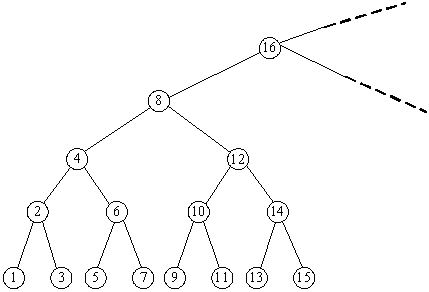POJ 2309 BST 【lowbit()过】
来源:互联网 发布:大数据必须掌握的技术 编辑:程序博客网 时间:2024/06/07 05:21
BST
Time Limit: 1000MS Memory Limit: 65536KTotal Submissions: 9189 Accepted: 5620
Description
Consider an infinite full binary search tree (see the figure below), the numbers in the nodes are 1, 2, 3, .... In a subtree whose root node is X, we can get the minimum number in this subtree by repeating going down the left node until the last level, and we can also find the maximum number by going down the right node. Now you are given some queries as "What are the minimum and maximum numbers in the subtree whose root node is X?" Please try to find answers for there queries.


Input
In the input, the first line contains an integer N, which represents the number of queries. In the next N lines, each contains a number representing a subtree with root number X (1 <= X <= 231 - 1).
Output
There are N lines in total, the i-th of which contains the answer for the i-th query.
Sample Input
2810
Sample Output
1 159 11
恩,题目大意就是说,上面那幅图,给出一个节点,输出该节点的左子树的左子树的。。。。一直到最底层的最小值,和该节点的右子树的右子树的最底层的最大值,奇数就是它本身输出也要有最小值和最大值,至于偶数,判断一下lowbit(n)的值,若和它本身相等,就是1 和 n+n-1 若不等,则是 n -lowbit(n)+1 和 n+lowbit(n)-1;
#include <iostream>#include<cstdio>#include<cstring>#define LL long longusing namespace std;LL lowbit(LL t){ return t&(t^(t-1));}int main(){ LL n; int t; scanf("%d",&t); while(t--) { scanf("%lld",&n); if(n&1) printf("%lld %lld\n",n,n); else { LL tem=lowbit(n); if(tem==n) printf("1 %lld\n",n+n-1); else printf("%lld %lld\n",n-tem+1,n+tem-1); } } return 0;} 0 0
- POJ 2309 BST 【lowbit()过】
- poj 2309 BST(lowbit)
- POJ 2309:BST lowbit
- poj 2309 BST 使用树状数组的lowbit
- poj 2309(树状数组lowbit)
- poj 2309 BST (^ ^)
- POJ 2309 BST
- poj 2309 BST
- POJ 2309 BST
- POJ 2309 BST
- BST - POJ 2309 水题
- POJ 2309 BST
- POJ 2309 BST
- poj 2309 BST
- poj 2309 BST
- POJ 2309 BST
- Poj 2309 BST
- POJ 2309 BST
- Java- Hibernate 简介
- 关于两个整数的交换的几种写法
- switch
- Git远程操作详解
- javascript生成二维码
- POJ 2309 BST 【lowbit()过】
- Java-Hibernate - EJB 注解映射
- 《秘密》卷一:秘密-健康的秘密
- 拖动图片移动
- bootstrap中六种表格样式
- jsp常用内置对象
- LintCode-剑指Offer-(376)二叉树路径求和
- Java-Hibernate 一对多关系映射
- acm2028


